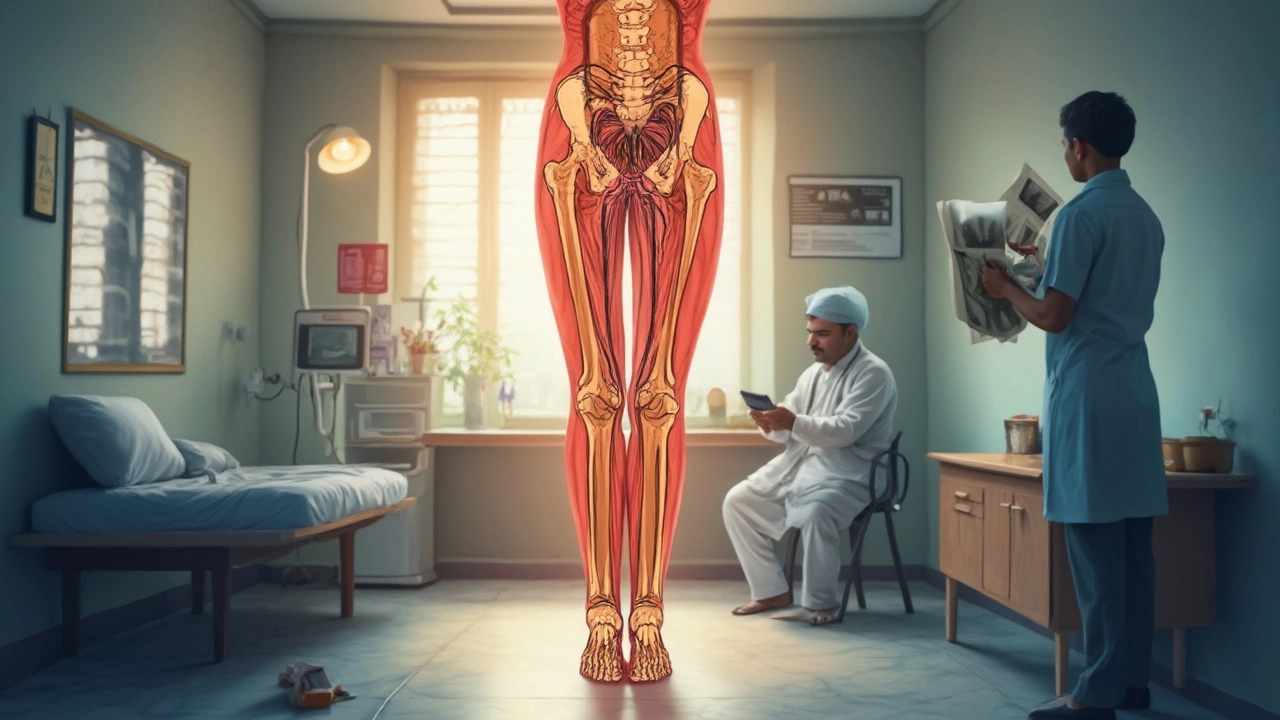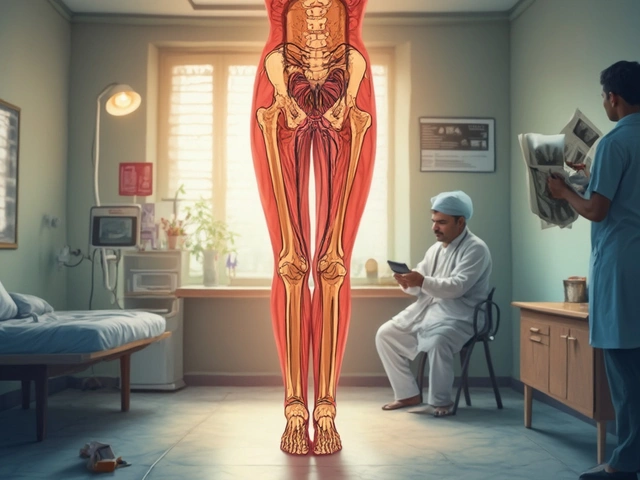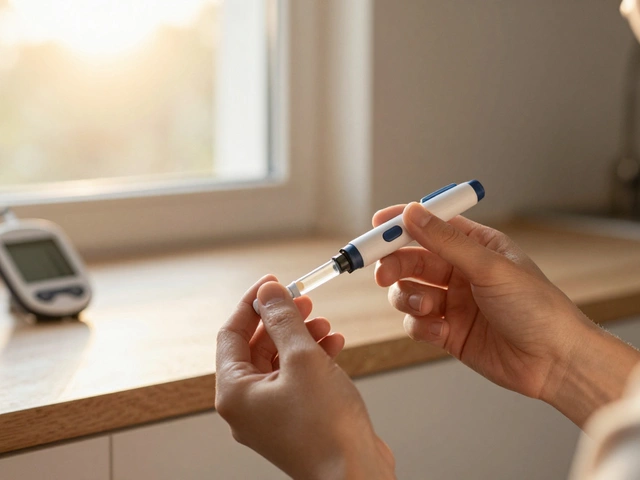- Home
- Orthopedics
- Hardest Bone to Heal: What Makes the Femur So Tough?

Hardest Bone to Heal: What Makes the Femur So Tough?
The femur is the heavyweight champ when it comes to difficult bone fractures. If you’ve ever known someone with a broken thigh bone, you already know recovery isn’t quick or easy. Why does this bone make doctors sweat? For starters, it’s the longest and strongest bone in your body—basically the main pillar holding you up. When it breaks, it’s usually because of a seriously hard impact, like a car accident or a nasty fall. That means the damage is often severe, and everything around it gets affected too, from big muscles to major blood vessels.
Healing a femur isn’t just about putting two ends together and waiting. There’s a huge risk for complications—think blood clots, infections, and sometimes permanent changes in how you walk. If a kid like my son Devansh cracked his femur, the whole family routine would come to a halt. That’s why orthopedic doctors pull out all the stops with rods, screws, or plates just to get the bone stable enough to start healing. The journey back is long, but knowing what makes it so tough can help you spot problems early and handle recovery better.
- Why the Femur Is the Hardest Bone to Heal
- What Makes Femur Breaks So Complicated
- Unexpected Problems During Recovery
- Tips for Faster Bone Healing and Less Pain
Why the Femur Is the Hardest Bone to Heal
The femur, or thigh bone, takes the title for the hardest bone to heal for a few clear reasons. First, it’s the biggest and strongest bone we’ve got, and that means it doesn’t just crack easily—the force needed to break it usually causes massive damage all around. So when it’s broken, it’s not just the bone that’s hurt, but also muscles, nerves, and sometimes arteries.
Another challenge? The femur has to handle all your body weight, all day, every day. Unlike smaller bones, like in your wrist or fingers, there’s no practical way to avoid using your leg, even with crutches. Immobilizing it fully is tough, which can slow down recovery for any femur fractures.
Blood supply is a big deal too. While the femur does have a good initial blood supply, the trauma from a break can mess this up, making it way harder for healing cells to do their job. Kids’ femurs usually heal faster, but for adults, especially those over 50, healing can be up to twice as slow.
| Average Healing Times | Age Group |
|---|---|
| 8-12 weeks | Children |
| 12-16 weeks | Adults under 50 |
| 20 weeks or more | Adults over 50 |
Let’s not forget the risks involved. Broken femurs almost always need surgery, and sometimes patients have to avoid putting any weight on the leg for months. This increases the chance of complications, like muscle loss, blood clots, or even infections. That’s why recovery from a femur break is a marathon, not a sprint, compared to bones like the collarbone or wrist that bounce back much faster.
What Makes Femur Breaks So Complicated
It’s no joke—breaking your femur is usually a sign that something really serious happened. The amount of force needed to snap this giant bone is massive. Unlike a wrist or a toe, your femur sits deep, surrounded by thick muscles and big blood vessels. When it breaks, these tissues often get torn or bruised too, which makes healing even more of a hassle.
Putting the bone back together isn’t as simple as slapping on a cast. Most femur fractures need surgery with metal rods or plates to hold everything in place. The bone won’t even think about healing properly if it isn’t lined up just right. Plus, the blood supply in the femur is easily disrupted by the break itself, which can slow down recovery. No one wants to end up with a leg that’s shorter or bent weird because the bone healed funny.
If you’re wondering why everyone takes femur fractures so seriously, this quote sums it up:
"Femur fractures are one of the most challenging orthopedic injuries due to the risk of severe blood loss, associated injuries, and potential long-term disability." — Dr. Ravi Kumar, Senior Orthopedic Surgeon, AIIMS Delhi
Bleeding is a real risk. A broken femur can actually cause blood loss inside the thigh—sometimes up to a whole liter. That’s why quick hospital treatment is crucial.
To put things in perspective, here’s how femur fractures stack up against other common bone injuries:
| Bone | Typical Cause | Average Healing Time (weeks) | Surgical Repair Usually Needed? |
|---|---|---|---|
| Femur | Major trauma (car crash, fall) | 12-24 | Yes |
| Wrist (radius) | Minor fall | 6-8 | Rarely |
| Collarbone | Sports injury, fall | 6-12 | Sometimes |
| Toe | Stubbing, dropping object | 4-6 | No |
After surgery, patients can’t just walk it off. They need weeks—sometimes months—of physical therapy to bring strength and movement back. If you’ve got a femur fracture or you’re helping someone who does, patience really is the name of the game. You can’t speed up bone healing, but sticking to doctor’s advice makes a huge difference.

Unexpected Problems During Recovery
Healing a femur fracture isn’t straightforward. You’d think lying still and waiting would work, but the truth is, even tiny hiccups can turn into big setbacks. One of the most common issues is a blood clot, technically called a DVT (deep vein thrombosis). It pops up because you’re not moving as much, and blood flow just slows down. There’s also a decent risk for infection, especially if you needed surgery and have metal rods or screws giving bacteria a place to hide.
What surprises a lot of people is the chance that one leg might end up shorter than the other after the bone heals. Even being off by a centimeter can mess with your walking and cause pain in your back or hips. Sometimes the bone just refuses to heal, which doctors call ‘nonunion’—it’s basically when your body taps out before the bone is solid again. This means you might need more surgery or have to wear special gear much longer than you expected.
Kids, teens, and older adults all have their own problems to deal with. Kids’ bones might heal crooked if the growth plate is involved, while older adults face slow healing and higher chances for complications. Pain, too, might stick around for months, making sleep and daily life rough.
- Blood clots: Being stuck in bed lets blood pool in your legs.
- Infection risk: Plates and screws are magnets for bacteria if wounds aren’t watched carefully.
- Limb length issues: Even a small difference affects your stride and balance.
- Nonunion or delayed union: Sometimes the bone healing stalls out completely.
- Chronic pain: Nerves around the femur don’t always go back to normal, causing ongoing soreness.
One study from a big hospital found around 5–10% of femur fractures run into healing trouble. The older you are, the bigger the risk. Staying alert for things like swelling, redness, or weird aches pays off—catching problems early can make a huge difference.
Tips for Faster Bone Healing and Less Pain
If you or someone in your family ever snaps the hardest bone to heal—like the femur—you’re looking at months, not weeks, of recovery. But there are smart ways to speed things up and dodge extra pain. The biggest thing? Stick to your doctor’s plan to the letter. Cutting corners might set you back months or even send you back to surgery.
Healing is about more than just taking it easy. Your body needs the right fuel. Protein, vitamin D, and calcium aren’t just buzzwords—your bones really can’t rebuild without enough of them. If you’re eating only junk, your body won’t have the materials it needs to bridge the break. Here’s a quick look at some food choices that help bones heal:
| Food Group | Best Choices |
|---|---|
| Protein | Eggs, chicken, fish, tofu |
| Vitamin D | Fatty fish, fortified milk, sunshine |
| Calcium | Cheese, yogurt, leafy greens |
Besides nutrition, keep these tips in mind to heal fractures like a pro:
- Keep moving—carefully. Listen to your doctor or physiotherapist. Gentle movement can keep your joints loose and speed up circulation, which brings in healing nutrients.
- Avoid smoking or vaping. Nicotine makes it much harder for bones to mend, and doctors can see the difference on x-rays.
- Take pain meds as prescribed. Don’t try to tough it out. Staying comfortable keeps your stress lower and lets you move as advised, which also helps healing.
- Commit to physical therapy. Whether it feels boring or even awkward at first, following every session helps get your strength and movement back.
One more thing: a huge study in 2021 showed that almost 6% of people with a femur fracture dealt with bone healing problems, usually because they didn’t follow aftercare advice or skipped follow-up visits. So, keep every appointment.
Slower healing can hit anyone, but if you’re a bit older or have health issues like diabetes, you might need extra patience. If things don’t seem right—like the pain stays sharp, or swelling won’t quit—call your doctor sooner rather than later.

Arnav Singh
I am a health expert with a focus on medicine-related topics in India. My work involves researching and writing articles that aim to inform and educate readers about health and wellness practices. I enjoy exploring the intersections of traditional and modern medicine and how they impact healthcare in the Indian context. Writing for various health magazines and platforms allows me to share my insights with a wider audience.
Popular Articles
About
Medical Resource Center India is a comprehensive online platform dedicated to providing reliable health information and medical resources in India. Explore a wide range of articles, tips, and advice on medicine, healthcare services, and wellness. Stay informed about the latest developments in Indian medicine and access valuable insights into maintaining a healthy lifestyle. Discover expert guidance and health solutions tailored for every Indian citizen. Your go-to destination for authoritative medical knowledge in India.


